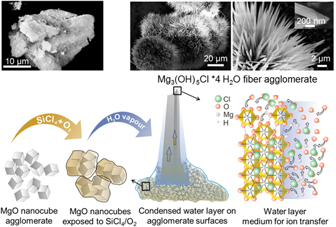Crossref Citations
This article has been cited by the following publications. This list is generated based on data provided by
Crossref.
Vlasov, V. P.
Muslimov, A. E.
and
Kanevsky, V. M.
2020.
Water Adsorption on the (001) Surface of NaCl.
Journal of Surface Investigation: X-ray, Synchrotron and Neutron Techniques,
Vol. 14,
Issue. 5,
p.
1040.
Gao, Qingwei
Zhang, Yumeng
Xu, Shuting
Laaksonen, Aatto
Zhu, Yudan
Ji, Xiaoyan
and
Lu, Xiaohua
2020.
Physicochemical properties and structure of fluid at nano-/micro-interface: Progress in simulation and experimental study.
Green Energy & Environment,
Vol. 5,
Issue. 3,
p.
274.
Schwab, Thomas
Razouq, Hasan
Aicher, Korbinian
Zickler, Gregor A.
and
Diwald, Oliver
2020.
Apparent crystallite domain size growth in metal oxide nanocrystal ensembles: The importance of surface reactivity of powders for processing.
Open Ceramics,
Vol. 3,
Issue. ,
p.
100014.
Niedermaier, Matthias
Schwab, Thomas
Kube, Pierre
Zickler, Gregor A.
Trunschke, Annette
and
Diwald, Oliver
2020.
Catalytic activity, water formation, and sintering: Methane activation over Co- and Fe-doped MgO nanocrystals.
The Journal of Chemical Physics,
Vol. 152,
Issue. 7,
Huo, Xiangchen
Conklin, Davis R.
Zhou, Mingxia
Vorotnikov, Vassili
Assary, Rajeev S.
Purdy, Stephen C.
Page, Katharine
Li, Zhenglong
Unocic, Kinga A.
Balderas, Raiven I.
Richards, Ryan M.
and
Vardon, Derek R.
2021.
Catalytic activity and water stability of the MgO(111) surface for 2-pentanone condensation.
Applied Catalysis B: Environmental,
Vol. 294,
Issue. ,
p.
120234.
Schwab, Thomas
Niedermaier, Matthias
Aicher, Korbinian
Elsässer, Michael S.
Zickler, Gregor A.
and
Diwald, Oliver
2021.
Always cubes: A comparative evaluation of gas phase synthesis methods and precursor selection for the production of MgO nanoparticles.
Open Ceramics,
Vol. 6,
Issue. ,
p.
100104.
Thomele, Daniel
Baumann, Stefan O.
Schneider, Johannes
Sternig, Andreas K.
Shulda, Sarah
Richards, Ryan M.
Schwab, Thomas
Zickler, Gregor A.
Bourret, Gilles R.
and
Diwald, Oliver
2021.
Cubes to Cubes: Organization of MgO Particles into One-Dimensional and Two-Dimensional Nanostructures.
Crystal Growth & Design,
Vol. 21,
Issue. 8,
p.
4674.
Schwab, Thomas
Aicher, Korbinian
Razouq, Hasan
Zickler, Gregor A.
and
Diwald, Oliver
2021.
Segregation Engineering in MgO Nanoparticle-Derived Ceramics: The Impact of Calcium and Barium Admixtures on the Microstructure and Light Emission Properties.
ACS Applied Materials & Interfaces,
Vol. 13,
Issue. 21,
p.
25493.
Diwald, Oliver
and
Hartmann, Martin
2021.
Metal Oxide Nanoparticles.
p.
593.
Diwald, Oliver
2021.
Metal Oxide Nanoparticles.
p.
1.
Diwald, Oliver
2021.
Metal Oxide Nanoparticles.
p.
783.
Schneider, Johannes
Ziegler, Amelie
Zickler, Gregor A.
Dzik, Petr
Berger, Thomas
and
Diwald, Oliver
2022.
TiO2 anatase and rutile grains and the effect of particle printing on porphyrin adsorption.
Surface Science,
Vol. 722,
Issue. ,
p.
122083.
Vasudevan, A.K.
Ricker, R.E.
Miller, A.C.
and
Kujawski, D.
2022.
Fatigue crack tip corrosion processes and oxide induced closure.
Materials Science and Engineering: A,
Vol. 861,
Issue. ,
p.
144383.
Schwab, Thomas
Muchová, Eva
Aicher, Korbinian
Berger, Thomas
Ončák, Milan
and
Diwald, Oliver
2023.
Oxygen Radicals Entrapped between MgO Nanocrystals: Formation, Spectroscopic Fingerprints, and Reactivity toward Water.
The Journal of Physical Chemistry C,
Vol. 127,
Issue. 48,
p.
23332.
Luong, N. Tan
and
Boily, Jean-François
2023.
Water Film-Driven Brucite Nanosheet Growth and Stacking.
Langmuir,
Vol. 39,
Issue. 31,
p.
11090.
Luong, N. Tan
Holmboe, Michael
and
Boily, Jean-François
2023.
MgO nanocube hydroxylation by nanometric water films.
Nanoscale,
Vol. 15,
Issue. 24,
p.
10286.
Bulyarskiy, Sergey Viktorovich
L’vov, Pavel Evgenievich
Litvinova, Kristina Igorevna
Polomskikh, Vitaliy Sergeevich
and
Rudakov, Grigory Aleksandrovich
2024.
Water Dose influence to the ALD hafnium oxide process: Simulation and experiment.
Materials Today Communications,
Vol. 39,
Issue. ,
p.
108622.
Luong, N. Tan
Hanna, Khalil
and
Boily, Jean-François
2024.
Water film-mediated photocatalytic oxidation of oxalate on TiO2.
Journal of Catalysis,
Vol. 432,
Issue. ,
p.
115425.
King, Hubert
Murphy, Ryan
Baumann, Avery
Allen, Andrew
Nguyen, Huong Giang T.
DeBeer-Schmitt, Lisa
and
Ilavsky, Jan
2025.
Carbonation of Alkaline Earth Metal Hydroxides: Structure across Nano- to Mesoscales.
Energy & Fuels,
Vol. 39,
Issue. 10,
p.
4866.
